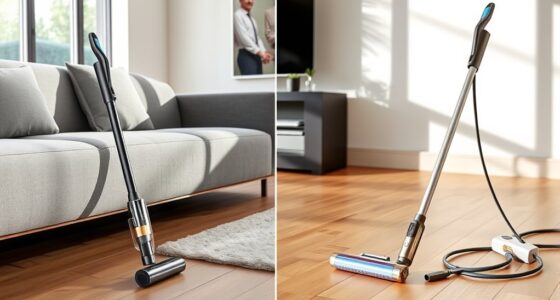Convection toaster ovens use a fan to circulate hot air, cooking food faster and more evenly, while conventional models rely on radiant heat, which can create hot spots and longer cooking times. Convection ovens offer more versatility with extra functions like baking and roasting, but they can be noisier and more expensive. If you want quicker, more consistent results or more cooking options, convection is the way to go; otherwise, conventional offers simplicity. Explore further to find the best fit for your kitchen needs.
Key Takeaways
- Convection toaster ovens use a fan for even heat distribution, resulting in faster cooking and browning compared to conventional models.
- Conventional toaster ovens rely solely on radiant heat, which may cause uneven cooking and longer baking times.
- Convection models typically cost more but offer greater versatility, including baking, roasting, and air frying functions.
- Conventional toaster ovens are generally more affordable, compact, and suitable for quick, simple tasks like toasting and reheating.
- Convection ovens can be noisier during operation and may over-brown delicate items, requiring careful monitoring.
Understanding the Basic Differences Between Convection and Conventional Ovens
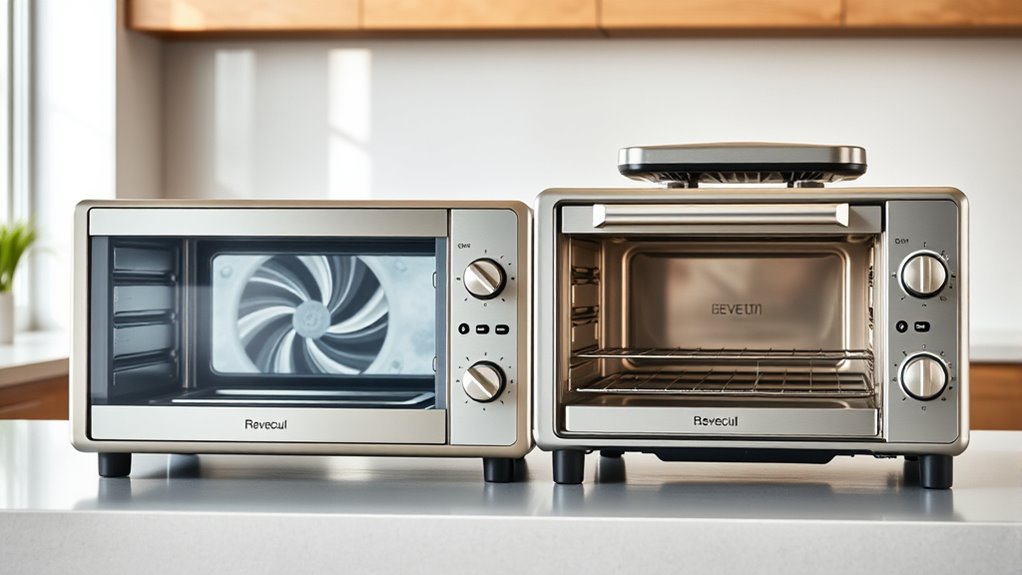
To understand the basic differences between convection and conventional ovens, it’s important to know how each heats food. Conventional ovens rely on passive heat radiation from electric elements or gas burners, providing radiant heat without air circulation. This can lead to uneven cooking, especially in larger models. Convection ovens, on the other hand, include a rear fan that circulates hot air around the food, ensuring even cooking and faster results. Many convection ovens also feature functions like Convection Bake and Roast, giving you more control. Some models are hybrid units, combining convection fans with traditional radiant heat, allowing you to switch modes based on your needs. Knowing these differences helps you choose an oven that best fits your cooking style and ensures consistent, even results. Additionally, proper oven maintenance can prolong the lifespan and efficiency of your appliance.
How Size and Space Influence Your Choice of Oven
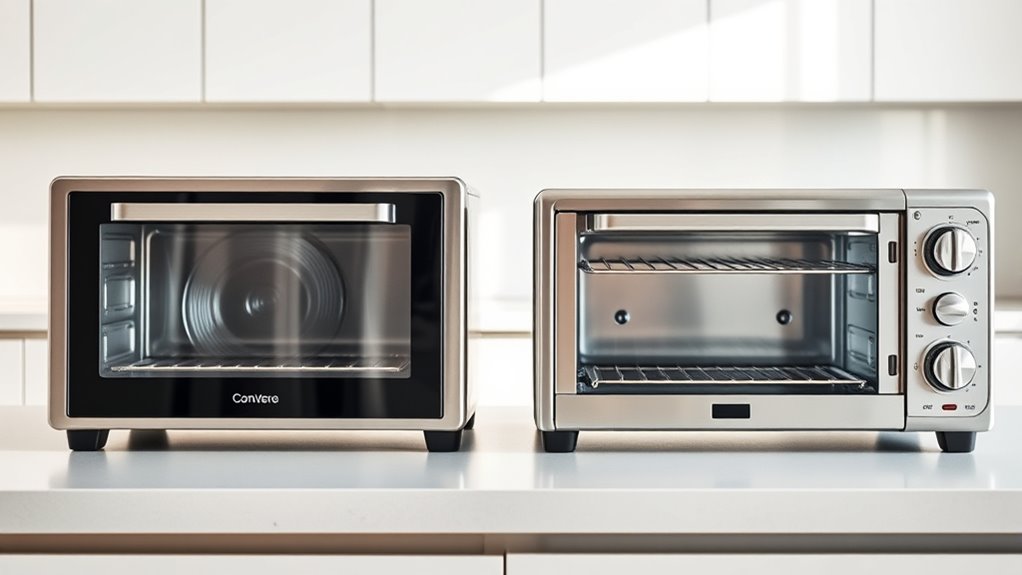
Your kitchen space and cooking needs should guide your oven choice. If you have limited room, a compact toaster oven might be perfect, while larger convection models work best for big meals. Consider whether you need a countertop or built-in unit to make sure it fits your space and usage. Additionally, choosing an oven that aligns with your organization goals can help maintain a tidy kitchen environment and prevent clutter buildup. Incorporating storage options that suit your cooking habits can further support a well-organized and functional kitchen setup. Understanding contrast ratio and its impact on image quality can also help you select appliances that are efficient and suitable for your lifestyle in a new environment.
Countertop vs. Built-in
Choosing between countertop and built-in toaster ovens largely depends on the available space and your kitchen layout. Countertop models are portable and compact, usually 15 to 20 inches wide, making them perfect for small kitchens with limited space. Built-in ovens, on the other hand, are designed to be integrated into cabinetry, saving counter space and offering a sleek, seamless look. Consider these points:
- Countertop ovens are easy to move and reposition.
- Built-in ovens require precise measurements and professional installation.
- Countertop models suit small kitchens with limited space.
- Built-in options are ideal for larger kitchens aiming for a streamlined appearance.
- The size and type of oven can influence your overall kitchen design and functionality such as choosing between a convection or conventional oven.
Additionally, the space available in your kitchen can determine the most practical choice for your needs. Incorporating kitchen layout considerations can help optimize your appliance choices and overall efficiency, especially when considering the drivetrain options for your bicycle, ensuring smoother gear changes and better performance.
Space for Larger Models
Larger convection ovens demand significant space, which can influence your kitchen layout and overall functionality. These ovens typically measure 24 to 30 inches in width, requiring ample counter space or built-in installation. Their bigger appliance size allows you to cook full-sized baking sheets, roasting pans, and multiple racks, making them ideal for large meals. However, their physical footprint may limit your kitchen’s flexibility, especially if space is tight. Unlike portable toaster ovens, convection models often need dedicated installation areas and can’t be moved easily. If your kitchen has plenty of room, a convection oven’s capacity and efficiency are worth the space commitment. But if space is limited, you might prefer smaller appliances that fit more easily without sacrificing convenience. Additionally, consider the floating on water feature of some models, which can influence placement and setup in your kitchen. When selecting a larger oven, it’s also important to evaluate how kitchen ergonomics will be affected by the size and placement of the appliance. Moreover, modern convection ovens often incorporate advanced technology that can enhance cooking precision and ease of use, making their larger size a worthwhile investment if space allows. Incorporating energy efficiency features can also help mitigate the increased energy consumption associated with larger models. Furthermore, understanding the affiliate marketing implications can help you make informed purchasing decisions, especially when shopping for high-end appliances.
Compact for Small Kitchens
In small kitchens, space is at a premium, making compact appliances like toaster ovens an ideal solution. Their space-saving design fits easily on countertops, freeing up room for other tasks. This is especially important if you have limited space for larger appliances. When choosing a compact countertop oven, consider these points:
- They take up considerably less space than full-sized convection ovens.
- Their size makes them easy to move and store when not in use.
- They’re perfect for reheating, toasting, or baking small batches.
- Larger ovens may require built-in installation or more counter space, which isn’t always feasible.
- A compact footprint allows for better utilization of limited kitchen space, ensuring you can keep essential appliances within easy reach.
- Additionally, their space-efficient design often incorporates multiple functions, maximizing utility in confined areas.
- Because of their multifunctionality, many models can replace several standalone appliances, saving even more space.
- Choosing a compact oven with adjustable racks and versatile settings can further enhance its usefulness in small kitchens.
- To optimize your kitchen organization, selecting appliances with stackable or modular features can further improve space management.
Comparing Cooking Speeds and Efficiency Levels
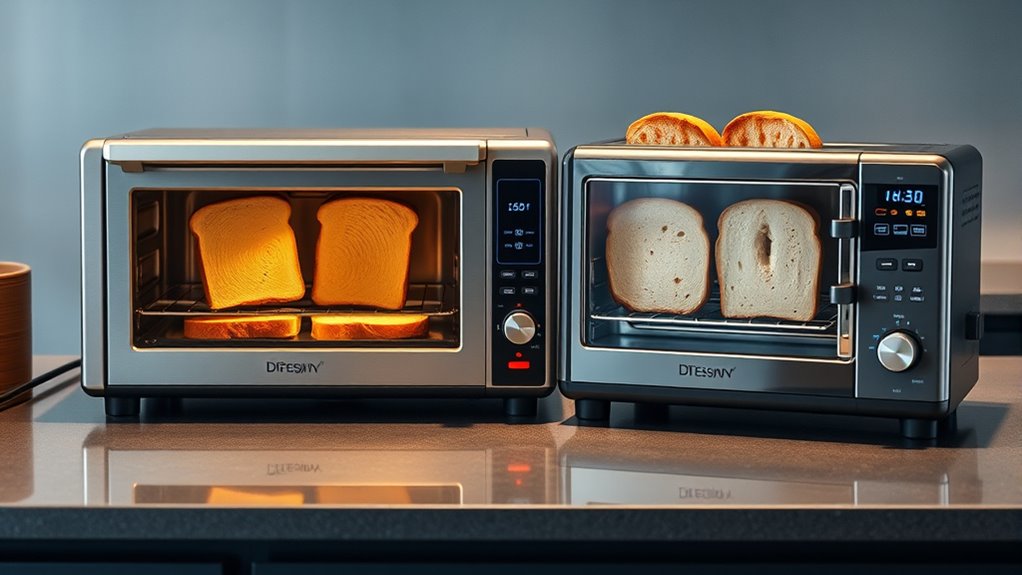
Convection toaster ovens are particularly faster than conventional models because their circulating hot air speeds up cooking times by approximately 25%. This circulation results in quicker cooking speeds, allowing you to prepare meals faster without sacrificing quality. Additionally, convection ovens are more energy efficient because they reduce overall cooking times and minimize heat loss. You can expect to save about 50% energy on small to medium meals compared to traditional models. The even heat distribution in convection ovens also means you don’t need to check or adjust as often, further improving efficiency. Overall, convection toaster ovens deliver faster results and lower operational costs, making them a smart choice if you value quick, energy-efficient cooking.
Versatility and Range of Functions Offered
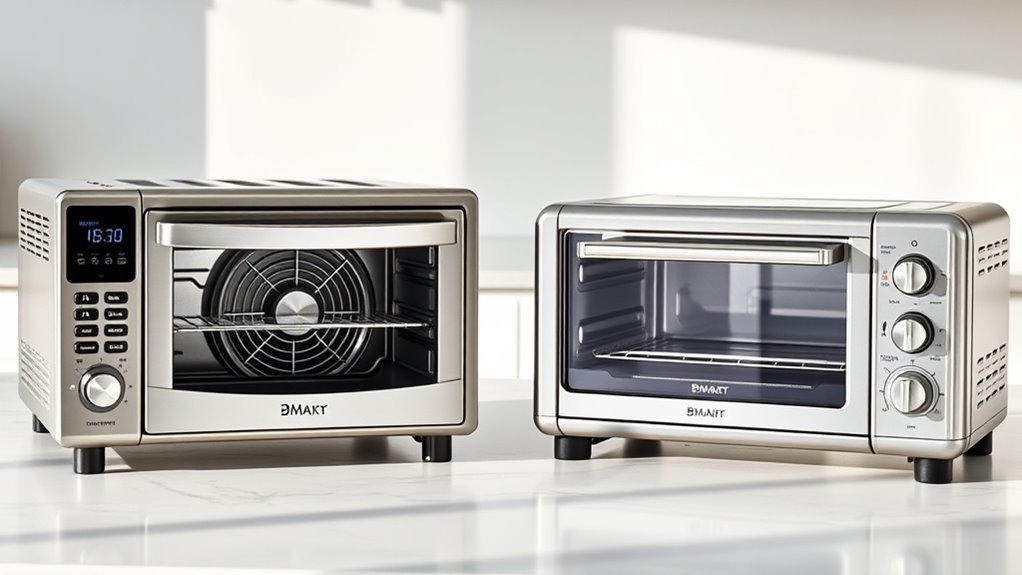
Convection toaster ovens offer a broader range of functions than traditional models, making them highly versatile for various cooking tasks. With convection ovens, you can do more than just toast; they include multiple functions such as:
- Baking, roasting, and broiling for diverse meal options
- Air frying for healthier, crispy results
- Specialized modes like Convection Bake and Convection Roast for precise control
- Faster cooking times due to fan-assisted circulation and even heat distribution
- Types of honey support a variety of culinary uses, enhancing flavor and nutritional value in your recipes. Additionally, some models incorporate energy efficiency features, helping reduce electricity consumption during extended use. Being aware of supermarket hours can also assist in sourcing ingredients for your recipes efficiently.
This expanded range of functions enables you to prepare a wide variety of recipes and techniques that go beyond basic toasting or reheating. The versatility of convection toaster ovens makes them suitable for both everyday meals and more advanced cooking, offering greater flexibility than conventional models.
Performance and Consistency in Cooking Results
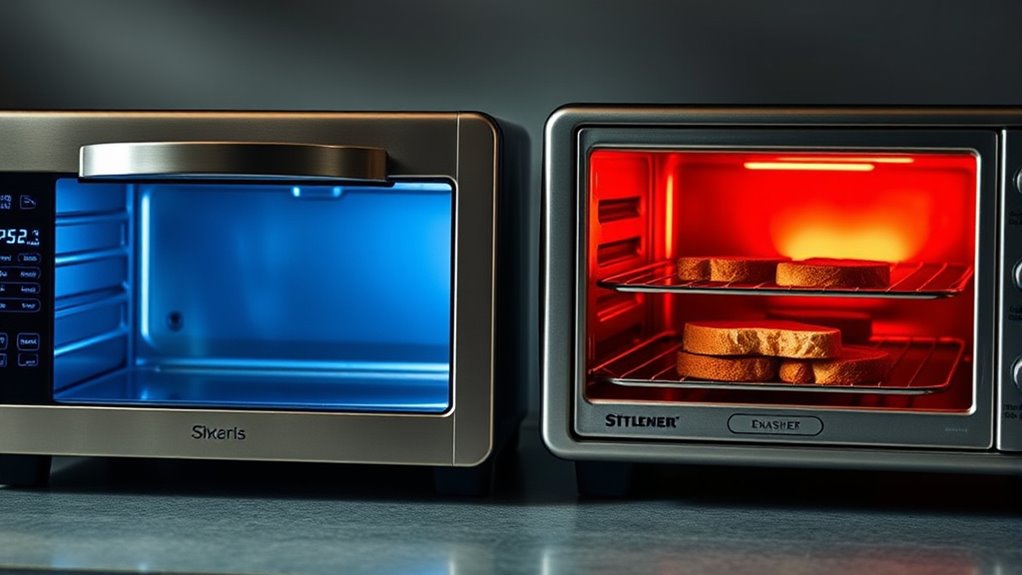
You’ll notice that convection ovens deliver more even heat, thanks to their circulating fan, which leads to more reliable browning and cooking results. Conventional models rely on radiant heat, often causing uneven cooking and hot spots. With better temperature stability and uniform heat distribution, convection ovens help guarantee your dishes come out consistently every time.
Heat Distribution Uniformity
The presence of a rear fan in convection toaster ovens actively circulates hot air around the food, leading to more even heat distribution. This ensures consistent cooking results and reduces hot spots. Compared to conventional ovens, which rely on passive radiant heat, convection models excel in maintaining uniformity. Consider these points:
- The convection fan promotes better heat distribution, preventing uneven browning.
- Shorter cooking times result from improved heat circulation.
- Baked goods and roasted dishes turn out more evenly browned.
- No need to reposition food, unlike in traditional models, for even cooking.
With convection ovens, heat distribution is more efficient, helping you achieve consistent results with less effort. This enhanced even cooking makes convection toaster ovens a reliable choice for baked and roasted dishes.
Temperature Stability Accuracy
Because convection toaster ovens actively circulate hot air with an internal fan, they generally maintain more stable temperatures during cooking. This improved heat stability results from precise temperature control features found in many modern models, often with digital displays that enhance accuracy. As a result, convection ovens experience fewer temperature fluctuations, which helps guarantee consistent cooking results. In contrast, traditional toaster ovens rely solely on passive radiant heat, making them more prone to uneven heat distribution and hot spots. When you open the door or cook for extended periods, temperature fluctuations can occur in conventional models, affecting the final outcome. Overall, convection ovens offer better temperature stability, making them ideal for delicate baking and roasting where consistent heat is vital.
Cooking Result Consistency
Convection toaster ovens deliver more consistent cooking results thanks to their even heat distribution, which is achieved by a rear fan circulating hot air throughout the chamber. This convection technology reduces hot spots and ensures more uniform doneness across your dishes.
To maximize cooking result consistency, keep in mind:
- Convection models minimize temperature fluctuations compared to traditional ovens.
- They produce more even browning and cooking, especially on baked goods and roasted meats.
- Repositioning racks isn’t usually necessary, unlike with conventional units.
- Hot spots are markedly less likely, leading to fewer burnt edges or undercooked centers.
Cost Implications and Long-term Investment Considerations
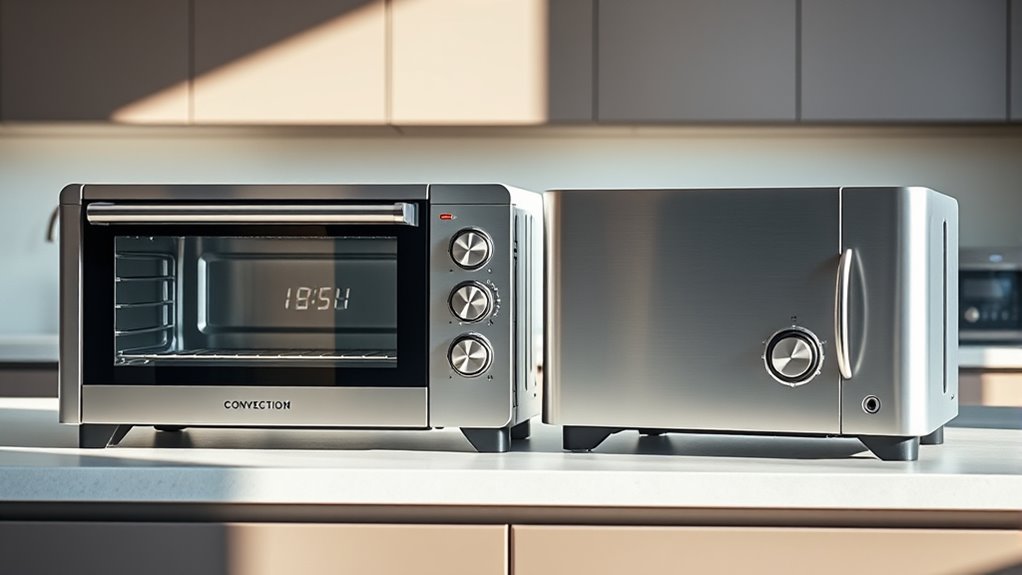
While convection toaster ovens typically come with a higher upfront price tag, their advanced features—such as faster cooking and more efficient heat distribution—can lead to savings over time. The initial cost of convection models ranges from $200 to $500, compared to as low as $40 for basic conventional units. Although the upfront investment is higher, convection ovens often save you money through energy savings, thanks to quicker cooking times and better heat efficiency. Over the long term, they can be a more cost-effective option, especially if you cook frequently. Plus, premium convection models tend to offer durability and extended warranties, reducing replacement costs. Ultimately, investing in a convection oven can be a smart long-term decision if energy savings and durability matter to you.
Ideal Users and Cooking Needs for Each Type

Your kitchen space and cooking volume needs play a big role in choosing between convection and conventional toaster ovens. If you have limited space or cook smaller batches, a compact conventional model might suit you best. Conversely, if you often prepare large meals or need more capacity, a convection oven can handle bigger tasks more efficiently.
Kitchen Space Requirements
Are you short on counter space but need a reliable oven for quick tasks? A conventional toaster oven is your best bet, thanks to its compact design that fits easily in small kitchens, apartments, or tight spaces. In contrast, convection toaster ovens are larger because they include built-in fans and multiple racks, requiring more kitchen space. Consider these points:
- Convection models typically need more countertop room.
- Conventional ovens are ideal for limited space.
- Choose convection if you plan to bake or roast larger meals regularly.
- Opt for a traditional model if your tasks are simple like toasting or reheating.
Your available kitchen space and cooking needs will determine the best fit, with compact conventional ovens perfect for minimal setups and convection ovens suited for versatile, larger-capacity cooking.
Cooking Volume Needs
Convection toaster ovens are best suited for families or anyone who regularly cooks large meals or multiple dishes at once, thanks to their bigger capacities that can handle nine slices of bread or a 13-inch pizza. Their increased capacity makes them ideal for batch cooking, holiday meals, and roasting larger cuts of meat. Convection ovens excel when you need to prepare multiple trays of baked goods or cook large portions, thanks to their even heat circulation. If your cooking volume frequently exceeds what a standard toaster oven can handle, a convection model will meet your needs more effectively. In contrast, conventional toaster ovens are smaller and better for quick, individual tasks with a capacity around 4-6 slices of bread. Your choice depends on your typical cooking volume and meal prep requirements.
Practical Benefits of Convection Technology in Everyday Cooking
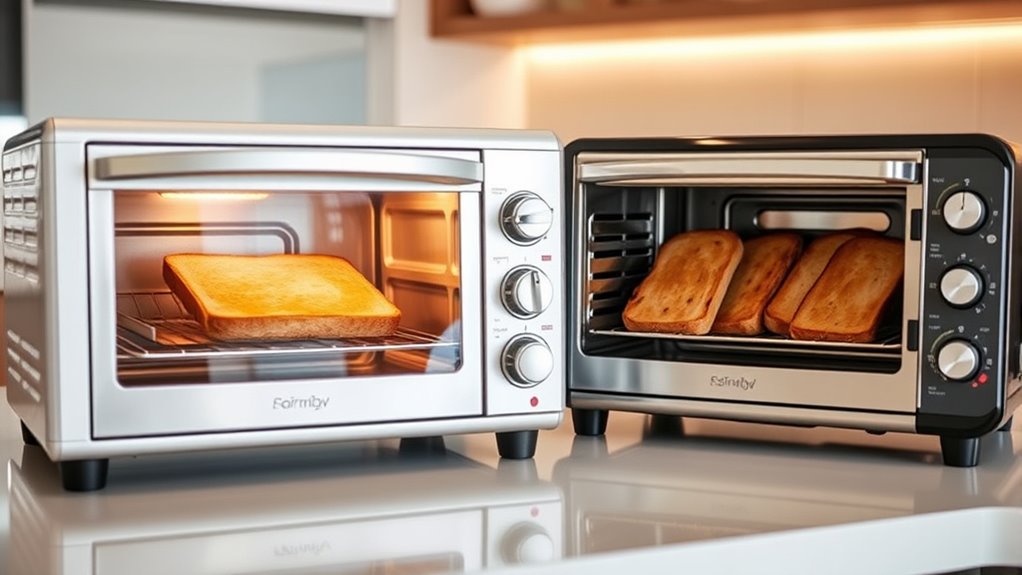
Convection technology offers several practical advantages for everyday cooking, making meal prep quicker and more consistent. The even heat distribution ensures your baked goods, roasted vegetables, and meats come out perfectly browned every time. Plus, convection ovens feature precise controls like Convection Bake and Convection Roast, giving you fine-tuned temperature management. Here are some key benefits:
- Faster cooking times—up to 25% reduction—saving you time in the kitchen
- Reduced preheat times for quick, unattended cooking
- Energy-efficient operation, using up to 50% less energy for small to medium meals
- Consistent results, eliminating hot spots and uneven cooking
Limitations and Drawbacks of Conventional and Convection Ovens

While convection ovens offer faster cooking and better heat circulation, they also come with notable limitations. Conventional ovens often have uneven heat distribution, creating hot spots that can lead to inconsistent cooking results. This uneven heat can be frustrating when baking or roasting, as some areas cook faster than others. Convection ovens, with their powerful fans, can cause delicate baked goods to over-brown or dry out, especially if you’re not careful. Both oven types require regular maintenance, such as cleaning fans or heating elements, to keep performance ideal. Additionally, convection models tend to be noisier during operation, which might be distracting. Overall, while both ovens improve efficiency, understanding their limitations helps you manage expectations and maintain them properly for reliable performance.
Tips for Selecting the Right Oven for Your Kitchen
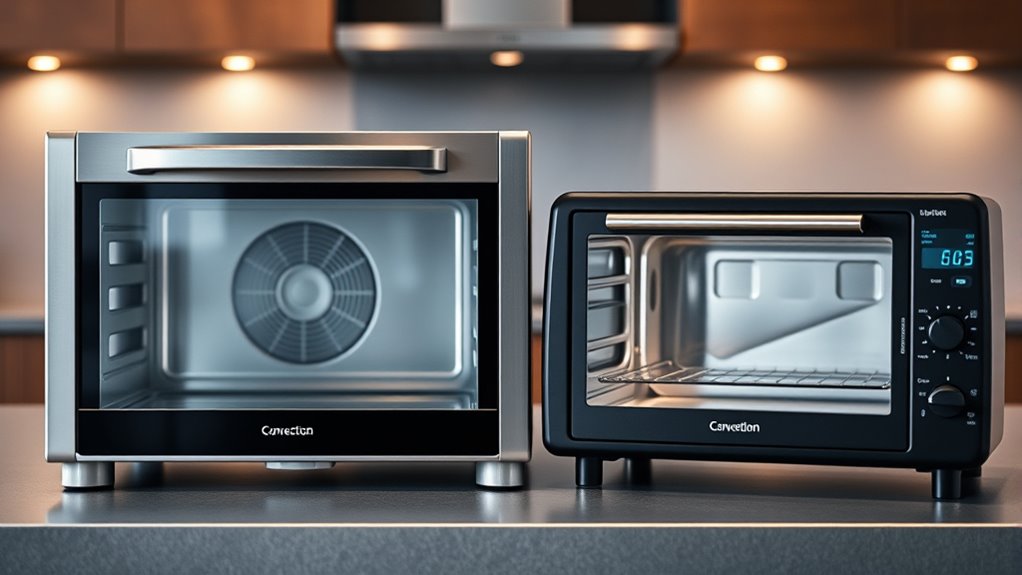
Choosing the right oven for your kitchen starts with evaluating your space and cooking needs. First, measure your available area to decide between a full-size convection oven or a compact toaster oven. Next, consider what you cook most often:
- Convection ovens excel at even roasting and baking, ideal for versatile cooking.
- Toaster ovens are perfect for quick toasting and small batches.
- Budget matters—convection ovens cost more but offer greater versatility.
- Look for models with adjustable convection fans and heating elements to customize performance.
Additionally, think about installation and energy efficiency. Convection ovens use more power but cook faster, while toaster ovens are portable and more energy-efficient for small tasks. Choose based on your space, budget, and cooking style.
Frequently Asked Questions
Is a Convection Toaster Oven Better Than a Regular Toaster Oven?
You might wonder if a convection toaster oven is better than a regular one. If you cook often or need faster, more even results, a convection model is a great choice because it cooks up to 25% quicker and offers better heat distribution. While it costs more, its versatility and efficiency make it ideal for everyday baking, roasting, and complex meals, saving you time and delivering consistent results.
What Is the Downside of a Convection Oven?
You might notice that a convection oven can cause uneven browning or overcook delicate baked goods because of the circulating fan. It also produces noise that could bother you during use. For certain recipes like soufflés or custards, the airflow can disturb their delicate structures. Additionally, convection ovens usually cost more upfront and consume more energy, and the hot air can make foods drier if you’re not careful with timing.
What Foods Should Not Be Cooked in a Convection Oven?
You might worry about cooking delicate foods in a convection oven, but it’s true that certain items don’t fare well. Avoid baking soufflés, custards, or meringues, as the strong air circulation can cause them to collapse. Also, skip cooking thin cookies or small pastries, which can burn easily. High-moisture foods like bread dough or seafood can dry out or cook unevenly, so stick to more forgiving recipes.
What Is the Equivalent of 350 in a Convection Oven?
When you ask about the equivalent of 350°F in a convection oven, you’re looking to adjust for faster cooking. Typically, you should set your convection oven to around 325°F to get similar results. Since convection circulates hot air, it cooks more efficiently, so lowering the temperature by about 25°F helps prevent overbaking while maintaining the desired browning and doneness.
Conclusion
Choosing between convection and conventional toaster ovens depends on your cooking style, space, and needs. Consider the speed, versatility, and consistency you desire, and weigh the benefits against the limitations. Whether you prioritize efficiency, function, or simplicity, picking the right oven enhances your kitchen experience. Make an informed decision, embrace the benefits each offers, and enjoy better, faster, and more delicious results every time you cook.


